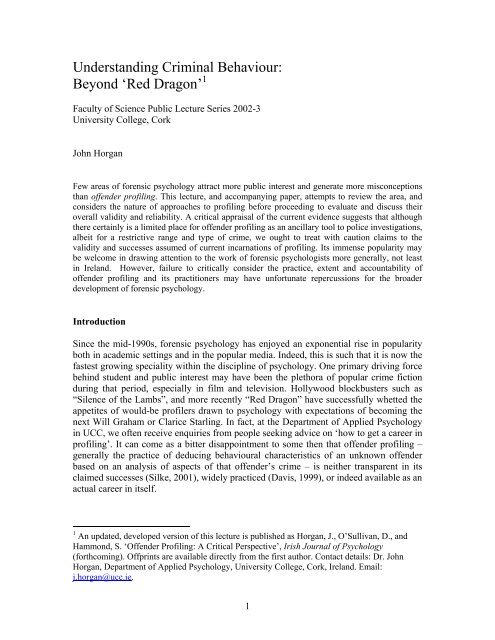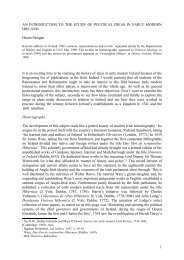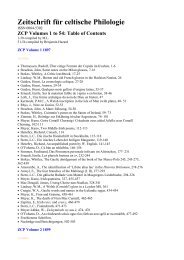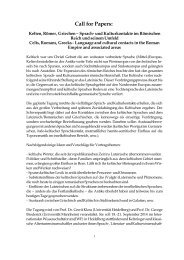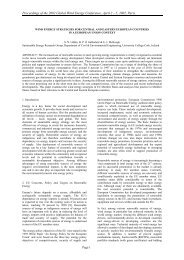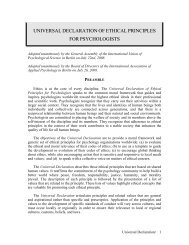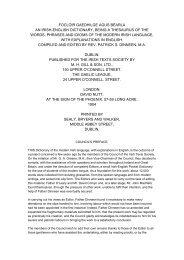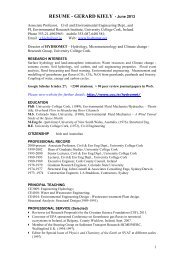Understanding Criminal Behaviour: Beyond Red Dragon - University ...
Understanding Criminal Behaviour: Beyond Red Dragon - University ...
Understanding Criminal Behaviour: Beyond Red Dragon - University ...
You also want an ePaper? Increase the reach of your titles
YUMPU automatically turns print PDFs into web optimized ePapers that Google loves.
<strong>Understanding</strong> <strong>Criminal</strong> <strong>Behaviour</strong>:<br />
<strong>Beyond</strong> ‘<strong>Red</strong> <strong>Dragon</strong>’ 1<br />
Faculty of Science Public Lecture Series 2002-3<br />
<strong>University</strong> College, Cork<br />
John Horgan<br />
Few areas of forensic psychology attract more public interest and generate more misconceptions<br />
than offender profiling. This lecture, and accompanying paper, attempts to review the area, and<br />
considers the nature of approaches to profiling before proceeding to evaluate and discuss their<br />
overall validity and reliability. A critical appraisal of the current evidence suggests that although<br />
there certainly is a limited place for offender profiling as an ancillary tool to police investigations,<br />
albeit for a restrictive range and type of crime, we ought to treat with caution claims to the<br />
validity and successes assumed of current incarnations of profiling. Its immense popularity may<br />
be welcome in drawing attention to the work of forensic psychologists more generally, not least<br />
in Ireland. However, failure to critically consider the practice, extent and accountability of<br />
offender profiling and its practitioners may have unfortunate repercussions for the broader<br />
development of forensic psychology.<br />
Introduction<br />
Since the mid-1990s, forensic psychology has enjoyed an exponential rise in popularity<br />
both in academic settings and in the popular media. Indeed, this is such that it is now the<br />
fastest growing speciality within the discipline of psychology. One primary driving force<br />
behind student and public interest may have been the plethora of popular crime fiction<br />
during that period, especially in film and television. Hollywood blockbusters such as<br />
“Silence of the Lambs”, and more recently “<strong>Red</strong> <strong>Dragon</strong>” have successfully whetted the<br />
appetites of would-be profilers drawn to psychology with expectations of becoming the<br />
next Will Graham or Clarice Starling. In fact, at the Department of Applied Psychology<br />
in UCC, we often receive enquiries from people seeking advice on ‘how to get a career in<br />
profiling’. It can come as a bitter disappointment to some then that offender profiling –<br />
generally the practice of deducing behavioural characteristics of an unknown offender<br />
based on an analysis of aspects of that offender’s crime – is neither transparent in its<br />
claimed successes (Silke, 2001), widely practiced (Davis, 1999), or indeed available as an<br />
actual career in itself.<br />
1 An updated, developed version of this lecture is published as Horgan, J., O’Sullivan, D., and<br />
Hammond, S. ‘Offender Profiling: A Critical Perspective’, Irish Journal of Psychology<br />
(forthcoming). Offprints are available directly from the first author. Contact details: Dr. John<br />
Horgan, Department of Applied Psychology, <strong>University</strong> College, Cork, Ireland. Email:<br />
j.horgan@ucc.ie.<br />
1
In an attempt to dispel such misconceptions it is necessary that we examine the nature<br />
and effectiveness of offender profiling, as well as approaches to it, but a prerequisite is<br />
that we first consider what exactly is meant by forensic psychology.<br />
In general, forensic psychology involves the application of psychological theories,<br />
principles and evidence to legal issues at a variety of levels of the criminal justice system.<br />
Forensic psychologists, may, for instance, assess a defendant’s pre-trial fitness to plead,<br />
advise legal professionals on the nature of interview strategies to be used with particular<br />
kinds of witnesses or suspects, deliver expert testimony within the courtroom, and<br />
sometimes advise on interview strategies used by the police in the interrogation of<br />
suspects and witnesses (Howitt, 2002; Keppel & Walter, 1999).<br />
While some forensic psychologists assist in the recruitment and/or training of police<br />
officers, others provide counselling and psychotherapy services in the context of<br />
occupational management issues, sometimes for problems such as post-traumatic stress<br />
or duty-related victimisation.<br />
Forensic psychology is still in its infancy in Ireland although it thrives in various<br />
jurisdictions including the United Kingdom, several countries in mainland Europe, the<br />
United States and Australia. In Ireland, forensic psychologists are currently found<br />
working in academic settings engaged in teaching and research (on areas such as the<br />
victimisation of children, child pornography, terrorism, delinquency, eyewitness<br />
testimony, offender assessment, etc.), or for the Department of Justice, Equality and Law<br />
Reform, prison and probation services in the assessment, treatment and management of<br />
offenders.<br />
The forensic psychologist may also assist police in their enquiries during a criminal<br />
investigation. It is in this context that forensic psychologists may be ‘called in’ to provide<br />
an offender profile.<br />
Offender profiling<br />
Within the context of criminological history more generally, the professionalisation of<br />
offender profiling is a recent development and its thrust into the media glare has been<br />
nothing less than phenomenal. Unfortunately, this is somewhat of a double-edged sword,<br />
serving to rather obscure the true extent of the encouraging progress of forensic<br />
psychology.<br />
Currently, offender profiling refers to an assortment of practices, all of which entail a<br />
psychologist or some other ‘external’ agency engaging at some level with the police in<br />
order to assist a criminal investigation in some way. While a multitude of definitions<br />
exist, a useful summary is provided by Gary Copson (1995), who defines offender<br />
profiling as:<br />
“Any predictions, recommendations and observations based on the inference<br />
of offender characteristics from behaviour exhibited in a crime or a series of<br />
2
crimes, and offered to the investigators as the product of statistical or<br />
clinical expertise” (p.v).<br />
The logic of offender profiling, in the main, is that behaviour expressed in relation to the<br />
commission of a criminal offence (which may be revealed before, during and after the<br />
crime itself) enables the ‘profiler’ to draw conclusions about the dynamics of that<br />
person's behaviour and personality (Michaud, 1986; Porter, 1983). In other words,<br />
features of the crime scene are assumed to reflect features of the offender’s behaviour and<br />
personality, such that understanding the nature of the crime scene and offence, we<br />
presume to understand something of the offender (Davis, 1999). This may reveal clues as<br />
to how offenders behave in everyday life, how they may be ‘distinct’ in some particular<br />
ways from others, what may be motivating them to offend in particular ways. A principal<br />
task of the profiler then is to dilute such deductions or inferences into a usable form for<br />
the police investigators. While the profile will not identify the criminal per se, the profile<br />
aims to help police investigators become “more attentive to individuals who fit that<br />
profile” (Davis, 1999, p.292).<br />
The earliest documented case of forensic analyses involving attempts at profiling<br />
perpetrators probably date to forensic analyses of Jack the Ripper’s victims during the<br />
Whitechapel murder cases of the late 19 th century (Turvey, 1999). Turvey describes how<br />
police surgeon Dr. George Phillips began to offer character inferences based on his<br />
minute examination of the nature of the wounds inflicted on the killer’s victims and the<br />
careful removal of their bodily organs.<br />
Profiling also appears to have a basis in attempts to conduct personality assessments of<br />
political leaders ‘at a distance’. The predecessor of the US Central Intelligence Agency,<br />
the Office of Strategic Services (OSS) requested a profile of Adolf Hitler from<br />
psychiatrist William Langer. Langer’s profile was solicited to attempt to inform the<br />
interrogation strategy proposed should Hitler be captured or otherwise defeated (Canter,<br />
1994). Langer successfully predicted that Hitler would choose to take his own life rather<br />
than face capture.<br />
One of the most celebrated early examples of profiling, however, comes from 1950s New<br />
York, and derives from Dr. James Brussel’s psychiatric profile of a serial offender,<br />
dubbed the “Mad Bomber” by the press. George Metesky, a disgruntled ex-employee of a<br />
local utility company, detonated over 30 explosive devices in locations all over the city.<br />
Brussel, a firm advocate of characterology and similar approaches that had dominated<br />
19 th century criminology, not only argued that “certain mental illnesses were associated<br />
with certain physical builds”, but also advocated during the Mad Bomber case the<br />
“diagnosis of an unknown offender’s mental disorders from behaviours evident in their<br />
crime-scenes” (Turvey, 1999, p.7). Brussel’s profile became popularised when his<br />
prediction that the offender would be wearing a buttoned, double-breasted suit was<br />
realized when the police came to question Metesky.<br />
Today, offender profiles tend to have one or more of the following objectives:<br />
3
1) The development of a description of an unknown offender, based on an<br />
interpretation of crime scene elements of the unsolved offence (this is perhaps the<br />
broadest, and most common purpose of profiling);<br />
2) Establishing the probability of a future offence from the same offender based on<br />
the crime scene analysis;<br />
3) The linking of a series of unsolved crimes that appear to share distinct features<br />
(e.g. often through linking ‘signature aspects’ – essentially personalized offenderspecific<br />
behaviours that reflect individual interpersonal behaviour and/or fantasy);<br />
4) The development of an interrogation strategy to assist police in ‘asking the right<br />
questions’. Again, this is based on a psychological portrait inferred from an<br />
analysis of the crime scene and/or statistical data from offenders thought similar<br />
to the unknown subject;<br />
The profile then is the production of these types of information for the police in the hope<br />
that it will somehow assist their efforts, even if only to help narrow down a list or ‘type’<br />
of potential suspects.<br />
In the main, profiling appears to be most useful in cases that suggest some psychological<br />
disorder in the offender, especially in attempting to ‘profile’ personality from crimespecific<br />
behaviour, or in a series of unsolved crimes that suggest patterned or distinct<br />
offence-relevant behaviours. Indeed, given these limitations, current concerns about the<br />
broadening remit of profiling may be warranted in light of existing efforts to assert its<br />
validity even within the remit of a relatively small number and type of offences. We<br />
should realise then that profiling lends itself to use in quite a narrow type of investigation.<br />
Profiles appear in cases of child abuse, abduction, but most typically in serious crimes of<br />
a serial nature including burglary, rape, arson, and murder.<br />
For the most part, the profiler is consulted in the late stages of investigation, and<br />
examines the crime scene from a distance via materials provided by the police, and often,<br />
but not exclusively, when police leads have been exhausted. It is something of a myth<br />
that psychologists regularly visit crime scenes, although it does happen from time to time.<br />
Typically, the information made available to a profiler will include case documents on<br />
the crime scene, victim-related information, forensic information, including a<br />
pathologist’s report, preliminary police reports, and a variety and range of photographs.<br />
The profiler will also draw on a degree of personal experience or expertise relating to<br />
knowledge of both the type of crime in question as well as the type of criminal suggested<br />
from the analysis of the crime. It is important that the profiler should possess<br />
criminological knowledge central to suggesting probable demographic attributes. In<br />
some cases, the profiler, if a psychologist, will rely on experience from clinical case<br />
studies, statistical models of offending and other potentially useful contributions. Overall,<br />
however, the profile is basically a summary document, often not more than 6-10 pages,<br />
4
ooted in personal judgements, a degree of educated guesswork, common sense and logic,<br />
and statistical and clinical probabilities. The profile is certainly not predicated on any<br />
specific ‘absolutes’ (Ainsworth, 2000).<br />
Profiles typically contain predictions of such information such as the offender’s sex,<br />
approximate age, race and other general characteristics (Ault & Reese, 1980). Usually,<br />
profiles contain suggestions related to whether or not the offender is likely to offend<br />
again, whether or not the offender may be forensically aware (i.e. perhaps through prior<br />
experience of the criminal justice system – e.g. via prior arrest - or through knowledge<br />
gained perhaps through textbooks on criminal investigations or forensic analyses, or in<br />
fact through previously undetected offences). In cases involving a sexual offence the<br />
profile might suggest details of the degree of sexual maturity of the offender or the role of<br />
specific fantasy themes in the offending behaviour (Turvey, 1999). Profiles may often<br />
also contain information related to the offender’s likely responses to police questioning<br />
and can result in the profile providing suggestions about the interrogative strategy to the<br />
police (often of particular use in rape cases (Keppel & Walter, 1999)).<br />
An important step in the production of a profile entails a reconstruction of the<br />
offence. The focus here is on the interaction between the offender and victim. Victim<br />
statements can thus be critical in order to ascertain the nature of verbal and physical<br />
behaviour displayed by the offender. The profile may then convey some form of<br />
classification of the offence. This can be important in indicating the likelihood of a reoffence<br />
in the future, so that the police and other agencies involved in the investigation<br />
may develop an intervention strategy aimed at warning a potential victim or group of<br />
victims (which may be symbolic or otherwise representative of the first known victim of<br />
a possible series).<br />
The above description of what profiling involves and the kinds of information provided<br />
probably represent a non-controversial view of profiling. Whatever the differences that<br />
might exist among the offender profiling community about some specific features of<br />
profiling, there are some fundamentally critical points we need to bear in mind. Given the<br />
multivariate nature of approaches to profiling, it is worth briefly describing the principal<br />
approaches currently dominating the practice. These are, in order of their systematic<br />
development: the FBI approach, the clinical psychological approach, the empirical datadriven<br />
approach (often encompassed under ‘investigative psychology’ or sometimes even<br />
‘statistical profiling’ in the UK), and more recently, the geographical approach.<br />
1. The FBI approach<br />
The FBI’s <strong>Behaviour</strong>al Science Unit, now its <strong>Behaviour</strong>al Sciences Investigative Support<br />
Services Unit (BSISSU), is the United States’ best-known clearinghouse for investigative<br />
queries that merit the production of an offender profile (Davis, 1999; Michaud, 1986;<br />
Porter, 1983). Typically, such requests derive from exhausted investigations at local<br />
levels, or involve the flagging of a series of unsolved crimes, typically murder, spanning<br />
two or more federal jurisdictions.<br />
5
The BSISSU, and the FBI’s entire approach to offender profiling developed primarily<br />
from research conducted from the 1970s through to the early 1980s that saw FBI agents<br />
interview and conduct detailed research on 36 imprisoned serial murderers (Ressler,<br />
Burgess & Douglas, 1988) and build on that data through a mixture of personal<br />
experience, intuition and educated guesswork.<br />
The serial killer research represents the data pool from which the logical underpinnings<br />
and statistical assumptions made about unidentified offenders (i.e. the unknown subject<br />
of the profiles) were derived. All were male, and while 29 of the 36 were immediately<br />
classified as serial killers, all of the offenders were suspected of having killed multiple<br />
other victims. The nature of these offenders’ crimes was what allowed them to be typified<br />
as a relatively homogenous group: often their murders involved elements of sexual<br />
sadism, mutilation and often bizarre and/or ritualistic imagery or behaviour. The<br />
relevance of these features, apart from suggesting broad psychological ‘problems’, was<br />
unclear to investigating officers and the FBI’s unit was turned to in order to decipher<br />
possible clues as to the ‘personality’ and ‘mental make-up’ of suspects in these types of<br />
criminal cases.<br />
In general, the FBI dichotomised the crime scenes of this group of offenders into two<br />
broad categories – organised and disorganised (Ressler et al., 1988; Turvey, 1999).<br />
Organised crime scenes reflected an overall level of control and planning, with offenders<br />
bringing their own weapons with them and generally coming prepared. The organised<br />
offenders carefully planned their offence, often using restraints in subduing the victim.<br />
Again reflecting an overall level of organisation, the organised offender would take care<br />
to transport the victim to a predetermined location both in the execution of the offence or<br />
sometimes post-mortem to hide the location of the body. The victim of the organised<br />
offender would be ‘personalised’, in that while the victim may have been a stranger, they<br />
were seen to represent a vital element of the offender’s fantasy (Ressler et al., 1988).<br />
Disorganised crime scenes on the other hand reflected polar opposites. The crimes often<br />
appeared the result of unplanned, spontaneous ‘blitz’-style attacks, often subsequently<br />
resulting in greater levels of exhibited violence reflecting an overall lack of planning and<br />
forethought. The overall crime scenes were ‘chaotic’, with little effort made to conceal<br />
either the victim, or materials used in the offence (e.g. weapons).<br />
Both the organised and disorganised crimes were then correlated with characteristics of<br />
the offender sample. Offenders with organised crime scene behaviour were found to<br />
possess an average or above average intelligence level, were socially and sexually<br />
competent, often living with a partner, were mobile (with a car), and often had a degree<br />
of negative stress precipitating the crime itself (e.g. through personal turmoil at home, at<br />
work, etc.). The organised offenders typically not only follow the reported progress of the<br />
criminal investigation through the media, but would even change jobs or leave town as a<br />
result.<br />
Offenders who displayed disorganised crime scene behaviour, on the other hand, were<br />
found to have below average intelligence levels, were socially, sexually and<br />
6
occupationally unskilled, were reported to be quite anxious during the commission of the<br />
crime, lived alone, and would not bother to ‘follow’ the news reports or make subsequent<br />
efforts to purposely avoid detection (Ressler et al., 1988).<br />
While the organised offenders’ behaviour and personality appear to reflect psychopathic<br />
behaviour (with the offender very much aware of their behaviour), the disorganised<br />
offenders were more typically representative of the presence of some psychotic disorder<br />
(Turvey, 1999).<br />
Howitt (2002) praises the FBI research for essentially producing a valuable body of<br />
knowledge from such a small sample size of offenders. The FBI model served as the<br />
blueprint for the hundreds of profiles constructed by the Unit annually.<br />
However, their findings and practices on which they were based have not escaped<br />
criticism. Canter (1994, p.10) reminds us that the term ‘offender profiling’ was created by<br />
the FBI, but that in doing so, they had inadvertently “created the impression of a package,<br />
a system that was sitting waiting to be employed, rather than the mixture of craft,<br />
experience and intellectual energy that they themselves admit is at the core of their<br />
activities”. It is generally recognised that the FBI approach does not easily conform to<br />
the rigours of scientific research (Godwin, 1998), and the dangers of both<br />
overgeneralisation and oversimplification are clear from the nature and extent of the<br />
research from which this dichotomy arose. In particular, trenchant criticism is offered by<br />
Turvey (1999), who asserts that the organised-disorganised dichotomy is essentially a<br />
false one, arising from “mistaken ideas about the developmental nature of criminal<br />
behaviour and the value of crime-scene reconstruction” (p.148). This, Turvey argues, can<br />
lead to confusion during the process of profiling as well as a failure to understand how a<br />
particular offender’s behaviour may develop over time. The problem of the categories not<br />
being mutually exclusive is also an issue raised by Godwin (1998), with the FBI<br />
developing a third category (‘mixed’) into which some offenders who display elements of<br />
both ‘organisation’ and ‘disorganisation’ are placed, or sometimes when the likelihood of<br />
the presence of more than one offender exists (Davis, 1999).<br />
To this day, the FBI (currently referring to their approach as ‘criminal investigative<br />
analysis’) do not make any aspirations to the development of profiling as a scientific<br />
endeavour, instead emphasising the primary role of basic ‘on the job’ law enforcement<br />
experience as the best predictor of success in dealing with such crimes.<br />
2. The clinical psychological approach<br />
This form of profiling typically is performed by clinical psychologists or psychiatrists<br />
who rely more heavily on clinical data and models of offending, although as Silke (2001)<br />
asserts, the clinician will prefer to regard each case as unique thereby deserving a detailed<br />
case-specific analysis and classification. In contrast to the FBI approach, clinical profiles<br />
suggest that less effort is made to fit the offender into what essentially may be an<br />
unsuitably rigid classification type, and rather than relying on investigative experience,<br />
7
the clinician relies on drawing inferences from expertise or experience with similar<br />
crimes and offenders, often in forensic and/or mental health settings.<br />
Given the increasing specialisation engaged in by psychologists (and forensic<br />
psychologists in particular), this form of profiling may on the surface appear quite potent<br />
for the police investigators: if the police consider consulting a psychologist on a rape<br />
investigation, there are several ‘rape experts’ available for consultation, whereas if the<br />
case involves serial arson attacks, one of several ‘arson experts’ are consulted, and so<br />
forth. In sum, individual skills and specialities are available for exploitation to their<br />
fullest potential.<br />
Clinical profiling is not without its faults however, and despite the overtly<br />
‘psychological’ base to this offender profiling approach, clinical profiling is not a<br />
uniformly discrete process. For example, clinical profilers could easily arrive at different<br />
profiles from the same profile inputs. This can reflect differences in the professional<br />
backgrounds and training of the clinicians as well as differences in their theoretical<br />
orientation within the discipline of psychology. Unfortunately, for the nature of the<br />
information provided to the police, what can follow from this is that different importance<br />
can be attached to interpreting aspects of the crime scene. In the context of efforts to<br />
establish the scientific credibility of offender profiling, the clinical approach could then<br />
be criticised as conceptually weak (i.e. we may in fact be simply identifying differences<br />
in the styles and procedures of individual profilers). A related limitation here is that in<br />
dealing with such an individualistic approach, there may be little sense of transparency<br />
regarding how the profiler arrives at his/her conclusions.<br />
From the police perspective, however, a traditional difficulty with clinical profiles is that<br />
much of the information provided could be interpreted as of little practical use to them.<br />
Some clinical profiles highlight issues to do with the significance of the murders to the<br />
offenders, “internal conflicts and fantasy life” (Canter, 1989, p.12), all of which Canter<br />
argues “are hidden from view and therefore not readily open to conventional police<br />
investigation”.<br />
3. The empirical data-driven approach<br />
Given that a major focus in offender profiling has been the classification of offences it is<br />
natural that a number of statistical approaches would emerge to address the problem. In<br />
fact, such developments were inhibited in the early years of offender profiling due to the<br />
fact that raw data was sparse and statistical treatments tended to be rather descriptive in<br />
tone (Perkins, Hilton & Lucas, 1990). However, with the advent of efficient database<br />
development the scope for statistical treatment of behavioural offence data has broadened<br />
and become well established. The CATCHEM database was probably one of the first in<br />
the UK developed by Derbyshire Police in response to the murder of three young girls<br />
(Aitken et al., 1995; Smith 1990). Other databases quickly emerged (Davies, Wittebrood<br />
& Jackson, 1997; Grubin & Gunn, 1990; Heritage, 1992) and the UK Police now<br />
typically use the VICAP (Violent <strong>Criminal</strong> Apprehension Program) system originally<br />
developed in Canada.<br />
8
The statistical procedures used vary enormously from Linear Discriminant Function<br />
Analysis and Logistic Regression (Davies et al., 1997; Smith 1990) through<br />
Multidimensional Scaling and Cluster Analysis (Canter & Heritage 1990; Grubin, Kelly<br />
& Brundson, 2001) to the more statistically sophisticated Baysian Belief Networking<br />
(e.g. Aitken et al., 1996).<br />
One of the more prolific advocates of the data driven approach is Professor David Canter<br />
at the <strong>University</strong> of Liverpool; he is one of the leading advocates of the development of<br />
‘investigative psychology’ in the UK. Canter (1989; 1994) encourages an empirical<br />
approach to profiling based on the collation of offence and offender characteristics and<br />
their subjection to statistical modelling in order to support any inferences of profile<br />
characteristics. The technique primarily employed by Canter and his colleagues (e.g.<br />
Canter & Heritage 1990) was multidimensional scaling (MDS) in which offences and/or<br />
their features were represented as points in space. The closer two points are found to be<br />
the more similar they are assumed to be. The specific techniques employed by Canter<br />
and his team derive from the work of Louis Guttman who developed the principle of<br />
‘smallest space’ (Guttman, 1968). Thus the MDS methods typically used are usually<br />
known as ‘smallest space analysis’ (SSA). Such an approach is essentially a way of<br />
developing a categorisation system of offender behaviours (e.g. violent behaviour,<br />
impersonal behaviour, intimacy behaviour etc.) thought to be crucial to understanding the<br />
interaction between offender and victim. As such it is a procedure for identifying and<br />
recognising patterns in large, complex datasets (Salfati, 2000). A major advantage of<br />
this data analytic approach over many of the others is that MDS is very forgiving of<br />
sparse and ‘muddy’ data, making very few assumptions about distributions or sample<br />
size.<br />
The data from each offence are inputted into the model and the profiler may be able to<br />
ascertain the likelihood of a series of offences. Where some surface elements may ‘flag’ a<br />
possible series, SSA attempts to assess the statistical probability of the offence being<br />
committed by the same offender, owing to similarities and trends in offender-victim<br />
interaction styles, before, during, and after the commission of the offence (also see Canter<br />
& Larkin, 1993).<br />
On the surface, the fact than an approach to profiling has proceeded with due caution paid<br />
to developing a theoretical basis is regarded as a positive development. Such an<br />
approach, if valid, would see the relative subjectivity of clinical judgement removed from<br />
the profiling process. This is because the profile would be rooted in empirical research<br />
and statistical probabilities deriving from a datapool of known offenders. What<br />
distinguishes the statistical approach however, and this is indicative of how openly<br />
critical Canter is of the FBI approach, is explained by Howitt (2002): the objectivity of<br />
such an approach may indeed represent a favourable feature, but the conclusions from<br />
such profiles may “not necessarily [be] more helpful to the investigators” (p.219), with<br />
the possibility of missing “salient features of individual cases” (Silke, 2001, p.245) an<br />
inevitable result of generalising across such large datasets (also see Turvey, 1999).<br />
9
One weakness that the data-driven approach has when compared to the clinical approach<br />
is that the latter may be of use in bringing experience to bear on a number of wider, yet<br />
equally pertinent issues. The statistical profile in isolation will not be able to offer<br />
inferences about the perpetrator’s background or other predisposing influences (and how<br />
these might influence the nature and/or extent of the offence in question).<br />
However, when considered with the geographical approach, to be described next, such<br />
data-driven approaches to profiling still represent the most encouraging progress made to<br />
date to support the assumptions and assertions inherent in profiling construction.<br />
4. The geographical approach<br />
This approach is probably the most recent, and is most commonly associated with the<br />
work of Kim Rossmo (1995, 1997). The basis for geographical profiling is that it may be<br />
possible to locate the probable residential or employment base of a criminal. This is<br />
based on an analysis of apparent patterns in the criminal’s offence characteristics. The<br />
theoretical underpinnings of this approach essentially borrow, as above, from<br />
mathematical and statistical models, but are interpreted on an individual basis through the<br />
filters of environmental and cognitive psychology.<br />
The approach involves assumptions about the spatial dimensions to behaviour (not<br />
necessarily ‘criminal’), and as such Rossmo’s method is typically associated with the<br />
need to understand the relevance of factors such as routine behaviour patterns of victims,<br />
the location of the offence, demographic attributes of the surrounding environment, etc.<br />
(Woodhams, 2002).<br />
Encouragingly, geographical profiling does incorporate findings from other approaches.<br />
Canter and Larkin’s (1993) work on serial rapists for instance suggests that offenders<br />
operate within distinctive “offence regions”. Their analysis of 45 male serial rapists<br />
illustrated that some serial offenders (the ‘marauders’) tend to hunt in areas with which<br />
they are familiar: 87% of the sample move outwards from their home base to conduct<br />
their attacks. Canter and Larkin also proposed the existence of ‘commuters’, thought to<br />
travel to a ‘target location’ both to hunt for and victimise targets.<br />
Canter and Larkin’s analysis demonstrated that offenders not only operate within<br />
distinctive regions but that the distance travelled tends to correlate directly with the<br />
distances between offences. The authors argue for the existence of ‘domocentric’<br />
behaviour in rapists, and suggest that the principles offered may be useful for testing in<br />
other, non-criminal behaviours (e.g. shopping, the search for new homes, etc.) (also see<br />
Brantingham & Brantingham, 1981; LeBeau, 1987).<br />
There are now a variety of computer software packages that will produce a colourful geospatial<br />
map of an area once the profiler has inputted the locations of a series of crimes.<br />
One of these is the Rigel program (Woodhams, 2002), which takes the profiling input<br />
details of several crimes and presents then a 2D or 3D surface map, displaying the<br />
10
“probable location of offender residence or employment using different colours”<br />
(Woodhams, 2002, p.36).<br />
Apart from the program taking, at times, up to two weeks to deliver its surface map,<br />
Turvey (1999) chastises the method for being about as “enlightening” as sticking pins on<br />
a big map and points to the perpetual error made by this and other forms of profiling in<br />
that an attempt is made to infer “meaning” from behaviours which are often taken “out of<br />
the overall behaviour and emotional context that it was produced in” (p.262).<br />
Nevertheless, geographical profiling represents an interesting development, and will<br />
continue to be tested in combination with data-driven approaches.<br />
Does profiling work?<br />
Current approaches to offender profiling do not easily lend themselves to objective,<br />
empirical evaluation. In some cases, this is due to the wide variety of practices and<br />
procedures (let alone the assumptions underpinning the appropriateness or otherwise of<br />
subsequent deductive/inductive decision-making styles with which to reach conclusions)<br />
that may constitute ‘offender profiling’ per se, as we will see below. It may well be the<br />
case that an attempt to evaluate the validity of profiles may tell us more about differences<br />
between the training, background and professional orientation of the profilers themselves<br />
than any firm conclusions about assumed uniformity in the practice of profiling. Given<br />
this, we ought to state that any profile must exist solely as an ancillary tool to a police<br />
investigation: it is essential that the profile be viewed as such and its limitations<br />
recognised both by profilers as well as the police.<br />
This question ‘does profiling work?’ is not as easy to answer as we might imagine, and<br />
indeed we may be forced to consider this question from a variety of perspectives,<br />
diverging agendas and mixed outcomes. A direct answer assumes that profiles have<br />
explicit objectives and that there is a sense of rigour associated with the refinement and<br />
development of profiling practices. Unfortunately, neither represents the current reality of<br />
offender profiling and numerous practical, conceptual and theoretical issues contribute to<br />
the complexity of any attempt to evaluate the effectiveness and utility of offender<br />
profiling.<br />
To begin with, we ought to perhaps reiterate the immense task faced by the very prospect<br />
of profiling. The profiler is essentially constructing a set of relatively subjective<br />
judgements and offering hypotheses about a person whom the profiler has never met. The<br />
potential for failure is therefore quite high (failure to reliably predict behaviour is already<br />
a challenge in everyday clinical assessment cases when the psychologist has access to the<br />
client). Some profiles are so vague as to be practically useless to the police, while others<br />
are so specific as to invite a complete lack of corroboration on key features. In less<br />
fortunate cases, this may end up skewing the nature of a police investigation, as the<br />
examples to follow illustrate.<br />
A significant problem in assessing profiling methodology involves lack of transparency.<br />
In cases in which psychologists contribute, these are usually high-profile criminal<br />
11
investigations with an unrelenting glare of publicity on any technique used by the police,<br />
especially anything remotely novel: the need for transparency and clarity is therefore of<br />
paramount importance for all parties involved. It may not be so difficult to answer why<br />
there are so few profiling cases made available for subsequent dissection and analysis –<br />
we rarely hear of or see the failures. It is essential for the development of profiling that<br />
the nature of the items provided in profiles must be individually assessed following the<br />
conclusion of an investigation. This would allow us to check for instance, which aspects<br />
of the profile have been correct, and which have been incorrect. It is inevitably the ‘hits’<br />
we hear about through the media – often specific items of information provided in the<br />
profile will be over-exaggerated in their importance (as evident in the Brussel case), but<br />
the ‘misses’ still tend to be shrouded in embarrassment and acrimony, with no clear sense<br />
of what was ‘right’ or ‘wrong’ about the profile. Relying on simplistic ‘accuracy rates’ to<br />
ascertain whether or not profiling works can thus be misleading. Without access to<br />
failures as well as successes, our conceptual development of this area will remain limited,<br />
particularly regarding how we might refine the nature of profiling objectives to more<br />
discrete, and possibly as a result, more achievable goals.<br />
While most profilers operate alone in the construction of their profile, ‘group’<br />
profiling is not necessarily more reliable: the team of psychologists and psychiatrists<br />
established during the 1960s recommended to the police that the murders later associated<br />
with Albert deSalvo, the “Boston Strangler”, were actually committed by two men, “each<br />
of whom lived alone and probably worked as a schoolteacher” (Porter, 1983, p.3) and one<br />
of whom was thought to be homosexual. In fact deSalvo lived with a wife, two children,<br />
worked in the construction industry and as Porter reminds us, “would never have been<br />
found by any of the policemen assigned to search the city’s homosexual community”<br />
(p.3).<br />
With this in mind, we should also note that the simplicity of definitions of profiling can<br />
be deceptive in evaluating the effectiveness of the practice(s) of profiling (Howitt, 2002).<br />
After all, all of the practices described in these forms of profiling reflect extremely<br />
complex psychological issues that relate to behavioural consistency (i.e. incorporating<br />
notions that we can actually derive any meaningful deductions or inferences at all from<br />
crime scene ‘behaviours’ that enlighten us as to what ‘type’ of person the offender might<br />
represent and the assumption that there is consistency in certain behaviours and<br />
personality traits more generally), the homogeneity of types of offenders (a point<br />
certainly represented in the FBI approach), and a host of other issues that, without<br />
empirical research and hypothesis testing, leave aspirations to the scientific bases of<br />
profiling wide open to easy criticism. The central hypothesis of profiling, according to<br />
Canter and Heritage (1990) remains that “offenders differ in their actions when<br />
committing a crime and that these differences reflect (and therefore correlate with)<br />
overtly available features of the offender” p.187) – but this is certainly a hypothesis open<br />
to empirical testing. If profiling is to be scientific (hence empirical), Boon (cited in<br />
Woodhams, 2002, p.34-35) argues that we must accept that profiles must be falsifiable<br />
and be “aiming to make a model of reality”. Boon argued that these difficulties could be<br />
overcome in approaches to profiling, but that true empiricism is probably too great a goal<br />
to aspire to. For present purposes, however, we can agree that the self-correcting nature<br />
of the scientific method is absent from most approaches to profiling, and the<br />
12
unfalsifiability of both the methods and principles underpinning the conclusions of<br />
profiles is akin to the conceptual problems that have plagued psychoanalytic analyses. In<br />
fact, it might come as no surprise to its detractors that psychoanalytic notions remain<br />
common in clinical profiles, and despite their unfalsifiability, their persistence owes<br />
much to historical precedents: in Brussel’s profile of the Mad Bomber, the psychiatrist<br />
deduced that Metesky hated his father but would love his mother - this derived from<br />
Brussel’s interpretation of the way in which Metesky “rounded out the sharp points in his<br />
W’s so that they resembled cartoon versions of a woman’s breasts” (in Porter, 1983, p.2).<br />
Even if such assumptions are empirically tested, there are a variety of practical matters<br />
we must consider in relation to strengthening the reliability of the methods used in<br />
profiling and the processes than underpin them. For a start, the quality of the information<br />
provided to the profiler (aside at all from any conceptual issues arising from inferring<br />
motive or deducing behavioural characteristics from behavioural ‘indicators’) is<br />
absolutely crucial to the process of producing a reliable profile. And, as with the<br />
criticisms levelled at the clinical approach, it is inevitable that some data sources will<br />
play a more significant role for individual profilers. It is not inconceivable that single<br />
pieces of profiling input data may serve to skew the direction, nature and results of any<br />
particular profile, regardless of what ‘kind’ of profiling produced it.<br />
Evaluations of the effectiveness of profiling continue to be very rare, with literally less<br />
than half a dozen such studies in existence (Copson, 1995; Jackson et al., 1993; Kocsis,<br />
1995, Pinizzota, 1984). Perhaps the most enlightening appraisal of offender profiling is<br />
that produced by, helpfully, a police officer. In 1995, Gary Copson, of the Metropolitan<br />
Police Service in London, conducted a ‘consumer survey’ of profiling activities. Copson<br />
(1995) scrutinised over 180 cases in which police investigators made use of 29 offender<br />
profilers, all psychologists or psychiatrists.<br />
In general, just over half the sample of police officers felt that they had received ‘some<br />
additional information’, although when pressed, this amounted to 14% of the sample<br />
agreeing that the profile had actually contributed in a practical way towards solving the<br />
crime in question. Corroborated in Copson’s analysis is the fact that profiles therefore<br />
rarely lead the police to the direct or immediate identification of an offender: although<br />
this remains one of the core myths of profiling, Copson reported only 3% of cases in<br />
which this appeared to happen.<br />
The results are not all so negative however, and we have some reason for considering<br />
other yardsticks for measuring the effectiveness of profiling. One positive finding from<br />
Copson’s study was that over 60% of police officers surveyed felt that it was helpful to<br />
have the profiler present. Many of these officers reported having been given a sense of<br />
reassurance and encouragement in the formulation of their own opinions and decisions,<br />
and having ‘experts’ on hand to reinforce those judgements felt beneficial. Consequently,<br />
about the same number of officers reported that they would certainly consult a profiler in<br />
future.<br />
13
The issue of difficulty in establishing the criteria for success was certainly illustrated in<br />
the Copson study. However, the profilers’ information (most of whom would have<br />
identified with the ‘clinical’ approach) appeared largely correct in over 2/3 of the data<br />
provided, but unfortunately, and again owing to the lack of empirical work on such cases<br />
following the conclusion of investigations, we are not clear on what kinds of information<br />
(and what patterns if any exist within and between them) the 1/3 of ‘incorrect’ data<br />
consisted of.<br />
Conclusions<br />
According to Silke (2001, p.243), offender profiling currently suffers from an identity<br />
crisis, with descriptions synonymous with ‘offender profiling’ including: “psychological<br />
profiling, criminal personality profiling, criminal personality assessment, criminal<br />
behaviour profiling, offender profiling, criminal profiling or investigative profiling”.<br />
Taken together with the multitudinal range of objectives expected (and proffered) within<br />
and from offender profiles, it is little wonder then that offender profiling remains “neither<br />
a readily identifiable nor a homogenous entity” (Gudjonsson & Copson, 1997, cited in<br />
Ainsworth, 2000, p.103; also see Homant and Kennedy, 1998 for suggestions to<br />
encourage distinctions between profiles in relation to their objectives). Although a sense<br />
of diversity in the area is important for theoretical progress, Bekerian and Jackson (1997)<br />
warn that too much diversity can lead to – and in the case of offender profiling to date,<br />
has led to – unintentional fragmentation and confusion. Given the relatively mixed results<br />
of profiling to date, we need to point to other influences to explain why offender profiling<br />
still occupies its distorted reputation and rather undeserved recognition.<br />
Part of this identity crisis is grounded in confusion about whether profiling necessarily<br />
requires a scientific basis. In asking whether offender profiling currently ought to be<br />
considered more an ‘art’, or soft science than anything remotely resembling sound<br />
empiricism, the current reality of profiling, and ‘current’ is emphasised, probably reflects<br />
an uneasy and perpetually shifting combination of both – the amount of each tends to<br />
alternate, sometimes dramatically so, from profiler to profiler and case to case. For a<br />
person to claim competence at any activity that might constitute the description of<br />
‘profiling’, an in-depth knowledge and understanding of the specific type of offender<br />
under scrutiny, as well as issues relating to the offence, is essential. Boon (cited in<br />
Woodhams, 2002) asserts that offender profiling contains elements of ‘art’ in that<br />
experience and creative talent play strong roles in the process of deducing a profile.<br />
The profiler should certainly clarify to the investigation team exactly what information he<br />
or she is likely to be able to offer and what the implications of that information might<br />
entail. This assumes, of course, that the profiler is very clear on what information is<br />
likely to be of use to the police. Sometimes profiles contain such jargon as to be of little<br />
practical relevance for the investigation team. The importance of recognising and<br />
acknowledging one’s limitations as a potential contributor to a police investigation<br />
cannot be overstated. According to Turvey (1999, p.266), investigators should only<br />
“enlist the services of competent professionals who are willing to engage in frank<br />
discussions about the limitations of their method.” Similarly, the police need to realise<br />
that it is unrealistic for any person, psychologist or otherwise, to possess an expert level<br />
14
of knowledge and understanding of every type of offence and offender. There have been<br />
past instances where profilers have been quick to offer assistance to any number and<br />
variety of offences, and the consequences have been damaging to existing attempts to<br />
develop the scientific qualities of profiling.<br />
According to Silke (2001), less than about 2% of all forensic psychologists will ever<br />
engage in offender profiling. The reality of profiling remains such that although<br />
Ainsworth (2000) describes the rate of profiling as increasing on an annual basis, it is still<br />
not nearly as common as we might like to imagine. Although the FBI consistently and<br />
systematically deliver profiles, UK and European practice is somewhat more contained<br />
and restricted. And while it may be at least of some comfort that the majority of the<br />
media-friendly profilers offering their unbridled assessments on the recent Washington<br />
snipers case were not psychologists, it can only take one public relations disaster to call<br />
into question not only offender profiling, but the parent speciality or even discipline<br />
espoused by the profiler.<br />
This was probably the only clear outcome of a lengthy and misguided police<br />
investigation in the UK that began with the murder of a young woman and ended with<br />
calls for offender profiling to be dismissed outright. Rachel Nickell was walking on<br />
Wimbledon Common with her young son, and in broad daylight was stabbed to death in a<br />
frenzied, vicious attack. Forensic psychologist Paul Britton was asked to help the<br />
investigation, and was specifically asked to provide a profile of the likely offender.<br />
Before long, the police identified nearby resident, Colin Stagg, as a possible fit to<br />
Britton’s profile, but had no incriminating evidence to ensure his conviction. The police<br />
found a sexual fantasy letter in Stagg’s apartment that Britton subsequently took as<br />
support for his profile theory that the killer would possess violent, sexualised fantasies.<br />
Britton subsequently advised the police to pursue a ‘honey-trap’ operation to ensnare<br />
Stagg (Wilson & Soothill, 1996). Using an undercover female police officer to engage in<br />
a relationship with Stagg, the officer (who used the pseudonym “Lizzie James”) would<br />
offer Stagg sex in return for his admission that he was capable of the kind of crime that fit<br />
the profile of the Nickell case. During the six-month undercover operation, however,<br />
Stagg held firm and although he eventually admitted to “Lizzie” that he had been quizzed<br />
by police investigating the murder, he adamantly denied he was responsible in any way<br />
for it. After a lengthy investigation, the police team was still no closer to identifying<br />
Nickell’s killer, and following a hearing at the Old Bailey, Britton’s role in leading the<br />
investigation was “strongly condemned” by the presiding judge (Wilson & Soothill,<br />
1996, p.13). The police were also openly pilloried for uncritically accepting the guidance<br />
of the psychologist and allowing him to apparently exceed the boundaries expected of<br />
any external support provided to the police.<br />
Although the lessons were learned by the police as far as maintaining an objective<br />
distance with psychologists was concerned, it is not merely the interests of individual<br />
profilers that can suffer (after all, Canter, the most vocal critic of Britton, argued that<br />
profiling itself was not at fault in this case, but that Britton himself had been unscientific:<br />
“what we’re dealing with here [in Britton’s analysis] is opinion presented as if it’s based<br />
on a great deal of expertise” (Wilson & Soothill, 1996, p.13).<br />
15
Fortunately, one thing that unites all critics (constructive or otherwise) of offender<br />
profiling is an acknowledgement of the lack of empirical research and the need to attempt<br />
to develop a sense of rigour throughout offender profiling practices (Salfati, 2000). This<br />
is inevitable if profiling itself is to develop, but is equally valid if forensic psychology<br />
should continue to be associated with profiling in any way. Through extensive hypothesis<br />
testing of the assumptions that informally underpin approaches to profiling, we should be<br />
able to move profiling beyond its depressingly introspective equation to “the Rorschach<br />
Test in the hands of the skilled technician” (Turco, 1990, p.150). That such empirical<br />
testing is possible is evident from some imaginative work to date (e.g. Kocsis, Irwin,<br />
Hayes, & Nunn, 2000).<br />
Given the infancy of forensic psychology in Ireland, confusion and false expectations in<br />
relation to the potential development of forensic psychology represent possible realities<br />
that neither the police nor psychologists can afford to entertain. We only do so through<br />
lack of openness, and the danger of any police force uncritically accepting psychological<br />
services are obvious in light of the Rachel Nickell case. As Ainsworth (2000) reminds us,<br />
although there is strong evidence to support the increasingly steady relationships between<br />
psychologists and the police, the expectations of police investigators of offender<br />
profiling, as well as the psychologists who engage in it, must be realistic, the process and<br />
its conclusions must be clear, intelligible, and perhaps most of all, open to scrutiny.<br />
Anything less than this would represent a disservice to both psychologists and the police.<br />
We will conclude with mention of an issue, identified by Canter (1989), but which may<br />
certainly be relevant to the Irish context. Canter asserts:<br />
“police officers are unlikely to admit psychologists to their investigations unless<br />
some mutual trust and reciprocal benefit is expected. This is a tricky cycle to break into,<br />
because it is difficult to make a contribution until some experience has been gained, yet<br />
difficult to gain experience until some contribution can be offered” (p.13).<br />
If offender profiling is ever to be considered in Ireland should the need arise, this<br />
fundamental challenge must be openly and successfully addressed by both the police and<br />
forensic psychologists. For the moment, however, the initial onus may well be on<br />
psychologists to demonstrate the relevance of their contributions to forensic settings. That<br />
this is already happening (e.g. Taylor & Quayle, 2003) represents encouraging progress.<br />
16
REFERENCES<br />
Ainsworth, P.B. (2000). Psychology and crime: Myths and reality. London:<br />
Longman/Pearson.<br />
Aitken C., Connolly T., Gammerman A., Zhang G. & Oldfield D. (1995). Predicting an<br />
offender’s characteristics: An evaluation of statistical modelling. Police Research Group<br />
Special Interest Paper 4. London: Home Office.<br />
Aitken C., Gammerman A., Zhang G. Connolly T., Bailey D., Gordon R. & Oldfield D.<br />
(1996). Bayseian belief networks with an application in specific case analysis. In A.<br />
Gammerman (Ed.) Computational learning and probabilistic reasoning. Chichester:<br />
Wiley.<br />
Ault, R.L. & Reese, J. (1980). Profiling: A psychological assessment of crime. FBI Law<br />
Enforcement Bulletin, 49, 22-25.<br />
Bekerian, D.A. & Jackson, J.L. (1997). Critical issues in offender profiling, in J.L.<br />
Jackson & D.A. Bekerian (Eds.). Offender profiling: Theory, research and practice.<br />
Chichester: John Wiley.<br />
Brantingham, P.J. & Brantingham, P.L. (1981). Notes on the geometry of crime. In P.J.<br />
Brantingham & P.L. Brantingham (Eds). Environmental criminology. Beverly Hills:<br />
Sage.<br />
Canter, D. (1989). Offender profiles. The Psychologist, 2, 12-16.<br />
Canter, D. (1994). <strong>Criminal</strong> shadows. London: HarperCollins.<br />
Canter, D. & Heritage, R. (1990). A multivariate model of sexual offence behaviour.<br />
Journal of Forensic Psychiatry, 1, 185-212.<br />
Canter, D. & Larkin, P. (1993). The environmental range of serial rapists. Journal of<br />
Environmental Psychology, 13, 63-69.<br />
Copson, G. (1995). Coals to Newcastle? Police use of offender profiling. Police Research<br />
Group Special Interest Paper 7. London: Home Office.<br />
Davies A., Wittebrood K. & Jackson J.L. (1997). Predicting the criminal antecedents of a<br />
stranger rapist from his offence behaviour. Science and Justice, 37, 161-170.<br />
Davis, J.A. (1999). <strong>Criminal</strong> personality profiling and crime scene assessment: A<br />
contemporary investigative tool to assist law enforcement public safety. Journal of<br />
Contemporary <strong>Criminal</strong> Justice, 15, 291-301.<br />
17
Godwin, M. (1998). Reliability, validity and utility of extant serial murderer<br />
classifications. The Criminologist, 22, 194-210.<br />
Grubin, D. & Gunn, J. (1990). The imprisoned rapist and rape. London:<br />
Institute of Psychiatry.<br />
Grubin D., Kelly P. & Brundson, C. (2001). Linking serious sexual assaults through<br />
behaviour. Home Office Research Study 215. London: Home Office.<br />
Guttman L. (1968). A general nonmetric technique for finding the smallest coordinate<br />
space for a configuration. Psychometrika, 33, 469-506.<br />
Heritage R. (1992). Facets of sexual assault: First steps in investigative classification.<br />
MPhil. Thesis. <strong>University</strong> of Surrey.<br />
Homant, R.J. & Kennedy, D.B. (1998). Psychological aspects of crime scene profiling.<br />
<strong>Criminal</strong> Justice and <strong>Behaviour</strong>, 25, 319-343.<br />
Howitt, D. (2002). Forensic and criminal psychology. London: Prentice Hall.<br />
Jackson, J., Van Hoppen, P.J. & Herbrink, J. (1993). Does the service meet the needs?<br />
Netherlands Institute for the Study of <strong>Criminal</strong>ity, mimeographed report.<br />
Keppel, R.D. & Walter, R. (1999). Profiling killers: A revised classification model for<br />
understanding sexual murder. International Journal of Offender Therapy and<br />
Comparative Criminology, 43, 417-437.<br />
Kocsis, R. (1995). Offender personality profiling: A viable investigative supplement.<br />
Bond <strong>University</strong>, mimeographed report.<br />
Kocsis, R.N., Irwin, H.I., Hayes, A.F. & Nunn, R. (2000). Expertise in psychological<br />
profiling: A comparative assessment. Journal of Interpersonal Violence, 15, 311-331.<br />
LeBeau, J.L. (1987). The journey to rape: Geographic distance and the rapist’s method of<br />
approaching the victim. Journal of Police Science and Administration, 15, 129-161.<br />
Michaud, S.G. (October 26 1986). The FBI’s new psyche squad. New York Times<br />
Magazine, 1-5.<br />
Perkins, D.E., Hilton, M. & Lucas M. (1990). A study of serial offenders in special<br />
hospital and prison. Report of the Home Office Science and Technology Group. London:<br />
Home Office.<br />
Pinizzotta, A.J. (1984). Forensic psychology: <strong>Criminal</strong> personality profiling – An<br />
outcome and process study. Law and Human <strong>Behaviour</strong>, 14, 215-233.<br />
18
Porter, B. (April 1983). Mind hunters. Psychology Today, 1-8.<br />
Ressler, R.K., Burgess, A.W. & Douglas, J.E. (1988). <strong>Criminal</strong> homicide: Patterns and<br />
motives. Lexington, MA: Lexington.<br />
Rossmo, K. (1995). Place, space and police investigations: Hunting serial violent<br />
criminals. In J. Eck & D. Weisbard (Eds.) Crime and place: Crime prevention studies<br />
Vol. 4. New York: Mouncey.<br />
Rossmo, K. (1997). Geographic profiling. In J.L. Jackson & D.A. Bekerian (eds).<br />
Offender profiling: Theory, research and practice. Chichester: John Wiley.<br />
Salfati, C.G. (2000). The nature of expressiveness and instrumentality in homicide:<br />
Implications for offender profiling. Homicide Studies, 4, 265-293.<br />
Silke, A. (2001). Chasing ghosts: Offender profiling and terrorism. In D.P. Farrington,<br />
C.R. Hollin & M. McMurran (Eds.) Sex and violence: The psychology of crime and risk<br />
assessment. London: Routledge.<br />
Smith V.O. (1990). Statistical profiling (CATCHEM): Report of confirmatory analysis.<br />
Report of the Home Office Scientific Research and Development Branch. London: Home<br />
Office.<br />
Taylor, M. & Quayle, E. (2003). Child pornography: An internet Crime. London:<br />
Routledge.<br />
Turco, R.N. (1990). Psychological profiling. International Journal of Offender Therapy<br />
and Comparative Criminology, 34, 147-154.<br />
Turvey, B. (1999). <strong>Criminal</strong> profiling: An introduction to behavioral evidence analysis.<br />
London: Academic Press.<br />
Wilson, P. & Soothill, K. (1996). Psychological profiling: <strong>Red</strong>, green or amber? The<br />
Police Journal, 69, 12-20.<br />
Woodhams, J. (2002). Conference report – Offender profiling: Current practices and<br />
future directions. Forensic Update, 68, 34-37.<br />
(This lecture was delivered at the UCC Science Faculty Public Lecture Series 2002-2003,<br />
on February 11, 2002.)<br />
19


